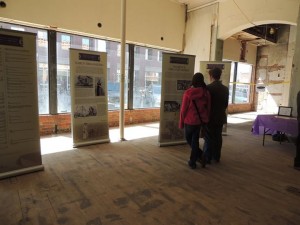Exhibit Details and Specifications

The exhibit consists of five free-standing, double-sided banners that retract into lightweight aluminum stands and come with a travel bag. Each panel measures 33” wide and 78” high. The ten panels address these topics:
- Introduction
- Timeline
- Early Organizing
- Women’s Organizations
- Tribal Politics
- The Movement in Montana
- Racism in the Movement
- Opposing Forces (anti-suffrage)
- The National Campaign
- Political Legacies and Ongoing Struggles
To schedule the exhibit for your library, contact Jo Flick, Statewide Training and Development Specialist, Montana State Library, 406-431-1081 or jflick@mt.gov. If you are a museum, please contact your local library to cooperatively schedule an exhibit showing for your town. This video features Julie Edwards, a Librarian at the University of Montana, as she explains how the exhibit came to be. She also showcases the content of the exhibit and directs libraries towards the resources they need for hosting the exhibit themselves. Leading the Way: Montana Woman Suffrage and the Struggle for Equal Citizenship from MSL Trainer on Vimeo.
This exhibit was developed with financial assistance from Humanities Montana, the American Association of University Women-Missoula, and the University of Montana’s African-American Studies Program, the University of Montana History Department, the Maureen and Mike Mansfield Library, and the University of Montana’s Women’s, Gender, and Sexuality Studies Program.
This exhibit will introduce you to fascinating individuals such as:
Mary Long Alderson, who served simultaneously as the president of the Montana chapter of the Women’s Christian Temperance Union and the recording secretary of the Montana State Suffrage Association, and successfully spearheaded the campaign to establish the bitterroot as Montana’s state flower in 1894. Mary B. Chappell, organizer of the Montana State Federal of Negro Women’s Clubs, who claimed “the rights of the minority” and opened a discussion of anti-lynching legislation at the group’s first meeting in 1921. Helen Piotopowaka Clarke, the daughter of a Scottish merchant and a Blackfeet mother, who served three terms as school supervisor in Helena. On her deathbed, she whispered: “Children should have nothing but the greatest admiration and the greatest respect, the greatest love and reverence for their teachers.” Hazel Hunkins, a graduate of Billings High School, who picketed the White House on behalf of woman suffrage during World War I. When she was arrested and jailed for her offense, she insisted on her innocence with the irrefutable logic: “Women cannot be law-breakers until they are lawmakers.”

Jeannette Rankin, a graduate of the University of Montana, who went on to serve two terms in the U.S. House of Representatives and vote against U.S. entry into both world wars. Women suffrage, she asserted, was “the most important question before the American people in our world struggle for democracy.”